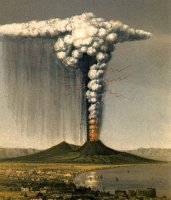
The origins of Pompeii are as old as those of Rome. The first Osian occupations – one of the oldest peoples of the Italian peninsula – date from the middle of the 7th century BC. AD, with perhaps a small hamlet around the crossing of three roads, between Cumae, Nola and Stabia.
This place was a place of obligatory passage between north and south, so coveted by the different neighboring powers.
The oldest known traces of settlement date back to the 6th century BC.
The city was first conquered by the Greek colony of Cumae around 500 BC. Strabo reports that Pompeii was subsequently conquered by the Etruscans. Recent excavations lend credibility to this information.
Around the middle of the fifth century, the Etruscans were beaten by the cumains – allied to Syracuse – during a naval battle near Cumae. Pompeii then passes under Greek control.
It is probably at this time that the tufa enclosure that protected more than sixty hectares, even though the city itself did not exceed ten hectares.

In the fourth century, Pompeii was involved in the Samnite Wars, at the end of which Rome asserted its hegemony over all of Campania. However, the city retained linguistic and institutional autonomy.
It is in the same century as the first regular urban plan of the city. Towards 300 new fortifications were raised.
During the Second Punic War Pompeii remained faithful to Rome, unlike many other cities in the region. By siding with the winner, it was able to maintain her partial independence.
In the second century BC, the intensive cultivation of the land and the export of wine and oil enriched the city where the standard of living became high. Particularly rich and luxuriously furnished houses are built. Among others, the house of fauna is almost 3000 m², the size of the royal greeks.
At the beginning of the Social War (91 BC) Pompeii was allied with all the cities of Campania against Rome, in an attempt to obtain full Roman citizenship. But in – 89, Sylla forced Stabia to surrender. He then besieged Pompeii, who attempted a valiant defense by reinforcing the enclosure, aided by Celts. This resistance was futile and the city fell.
In – 80, Pompeii permanently integrated the orbit of Rome and Sulla, which transferred there a colony of veterans. He gave it the name of Colonia Cornelia Veneria Pompeianorum. As was customary, land was allocated to the veterans, of course to the detriment of the former opponents. However, the city remained prosperous, the well-being and the trade of the Pompeians relying primarily on the export of the wines of the region .

For its climate and its suggestive landscape, Pompeii and its surroundings were a pleasant holiday resort for wealthy Romans, including Cicero who owned a house there.
The sources are rather meager about the life of the Pompeians during the first imperial age. An unusual event, however, is mentioned by Tacitus. It is the fight between Nucériens and Pompeians that took place in 59 AD in the amphitheater of Pompeii. Following this one, Nero forbade for ten years all spectacle of gladiators.
In the year 62 AD, the city was shaken by a violent earthquake. Many buildings were still under reconstruction during the eruption of 79 AD, the famous eruption of Vesuvius that fossilized Pompeii and its inhabitants.


